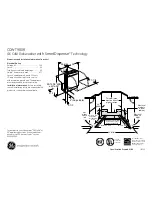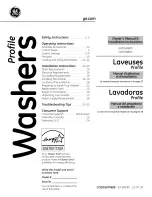
Home Repair Manuals Hotpoint WMA32 Dismantle & Repair
Page 4 of 50
1
INTRODUCTION
1.1
Preface
During the development of this manual it has become clear that a percentage of the
components have changed. Although the model number may be the same the independent
manufacturers of parts and there fittings are different on some machines to those on
another. Therefore it is quite possible that some of the information given may not
necessarily apply to your machine, likewise not all the photos will exactly resemble the
components on your appliance.
The dismantling and reassembly of the machine should be roughly the same, except in
the case of cold fill only machines; they do not have a hot valve. The basic faults and
there solutions are also fairly universal, however some of the more complex problems
and solutions may differ, due in part to the design and construction of the associated
components.
This manual is not intended to be a course in washing machine repairs or cover all the
faults associated with this particular model, but by referring to it may save you time and
added expense on less involved faults, or at the very least give you an insight as to what
the engineer is talking about, because it can be a bit of a task knowing a good engineer
from a dodgy one. So how can you tell them apart? The short answer is, unless you are
an engineer yourself you probably can’t ……well not at first anyway.
Here are two scenarios;
(1)
A good engineer inspects your machine and decides it needs a part he does not have. He
tells you he has to order it and leaves. Because of a delivery delay he returns a week later
and fits the part. While he is doing the normal functional check on your machine he
notices the water level is high so he cleans out the pressure chamber, then writes out the
invoice. You pay the bill but are not happy because you had to wait a week for the repair.
When he leaves your machine has been thoroughly tested and should work well for some
time. You however rate his quality of work as bad because of the extra time you were
without a machine.(Not his fault)
(2)
A bad engineer inspects your machine and has not got a clue what is wrong with it, so he
tells you he must order a part (possibly one he already has on the van) just to get out of
the house, so he can confer with a more knowledgeable colleague, and ask what would be
wrong with your machine. He returns the next day and fits the second-hand part he had
on the van, whether it is needed or not, as well as a few other bits, just to bump the price
up. No other checks or tests on the machine are carried out because that would take up
valuable time and a different fault rectified now would mean you would not need him
next week when it breaks down again. He hands you a very large bill but you are happy
because your machine was only out of action for a day. You rate this engineer as very
good.





































